Pig farming wastewater treatment is a necessary issue in large-scale livestock farms. Livestock wastewater often causes a very strong odor that affects the surrounding environment, and contains a lot of organic matter, easily causing eutrophication. chemicals cause pollution in the vicinity of the Discharge Area.
Composition and properties of pig farming wastewater
- Arising mainly from pig bath water, feces, urine and partly from leftover food.
- Livestock wastewater contains many bacteria, helminths, eggs, larvae…
- Affects human health.
- In addition, livestock wastewater also causes bad odors and pollutes the water environment
- On average, each day a pig produces about 20 liters of water and 1-2 kg of feces.
- Main component:
- Organic accounts for 70-80% including: Protein, amino acids, cellulose, fat, carbohydrates
- VMuscle cells account for 20-30% including: salt, urea, ammonium, chloride, SO42-, sand…
- Livestock wastewater has high pollutant content, typically COD about 6,000mg/l and Ammonium about 1,200mg/l.
What standards are applied to pig farming wastewater?
QCVN62-MT:2016/BTNMT (applicable to wastewater from pigs, cows, chickens, shrimps and fish..).
See QCVN62-MT:2016/BTNMT here
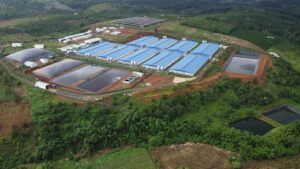
Wastewater treatment system at Nam Viet Customer
Pig farming wastewater treatment process
The basic livestock wastewater treatment process of Nam Viet ETC includes the following steps:
- Decomposition
- Biogas
- Processing system. Can apply complete biotechnology or physical chemistry combined with biology.
- Complete biotechnology has the advantage of low operating costs, but the initial investment cost of building a tank will be high.
- Physical and chemical technology combined with biology has lower investment costs but consumes chemicals during operation. Depending on the conditions of each customer, Nam Viet will advise on the appropriate plan
- Discharge to the Environment or reuse
In the pig farm wastewater treatment process Nam Viet ETC not only treats wastewater with the purpose of “disposing of it” but takes advantage of waste sources to reuse, save, and save money. Bringing value to the farm in an ecologically sustainable way.

Nam Viet engineer performed a “ceremony” before starting construction
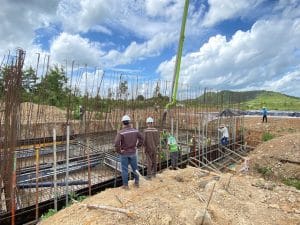
Pouring concrete into the wastewater treatment tank cluster
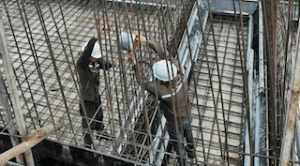
Nam Viet engineer placed connecting pipes between the tanks
Separation of manure in pig farming wastewater.
- The compost compactor will almost completely separate the amount of solid feces in wastewater
- Helps reduce pollution concentration in wastewater, saving costs of building treatment systems
- Utilize fertilizer for use in growing crops and sell it to fertilizer factories.
- The manure moisture after separation is 55-65% and can be used as compost for agriculture
- Feces must be collected regularly and transported by specialized vehicles to avoid bacteria, diseases, and odors.

Manure separator for livestock wastewater treatment system
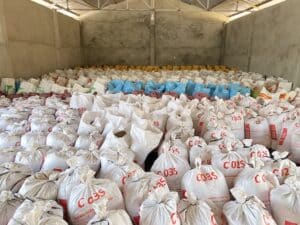
Selling pig manure after pressing is also a source of income for farms
Biogas helps reduce the concentration of pig farm wastewater pollution
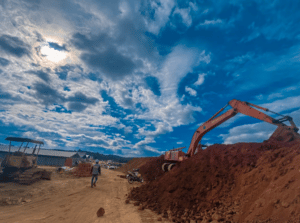
Digging Biogas tank and settling tank for Daknong pig farm
- Generates 60% Methane (CH4), 30% CO2, the rest are other gases such as N2, H2O, H2S.
- Of these, only CH4 is a gas that can be used as fuel
- The remaining is impure gas that needs to be filtered to not affect the quality of the gas
- In particular, H2S gas causes corrosion of gas pipelines and needs to be thoroughly filtered.
- Biogas can be used for cooking, heating, and providing gas for incinerators to destroy dead pig carcasses.
- Especially use Biogas to run generators to use for lighting in the camp or sell to the National Grid. Helps save energy costs for the camp and can earn profits from selling electricity to the grid.
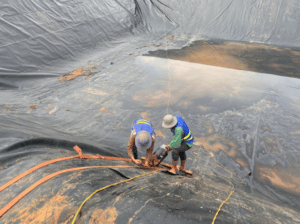
Carry out welding.
Technology diagram of pig farming wastewater treatment

Pig farming wastewater treatment technology combines Physical Chemistry and Biology.
Biogas treatment:
Biogas tank: Biogas technology is based on the operating principle of anaerobic microorganisms.
In the absence of oxygen, microorganisms decompose organic matter into active energy and methane gas.
The mixture of CH4 (Methane), hydrogen sulfide (H¬2S), NOx, CO2… forms biogas.
Biogas tanks under the influence of high-speed microbial products, combined with the impact of anaerobic microorganisms, will ferment wastewater, reducing the content of pollutants in livestock wastewater.
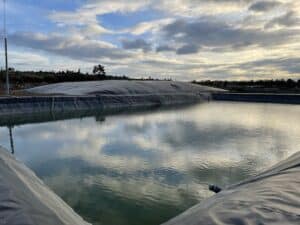
Biogas and Sedimentation Tank after Biogas
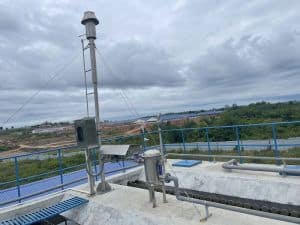
Excess gas burning equipment
Suitable for the load capacity of the livestock wastewater treatment system after Biogas, and at the same time produces Biogas gas to return to production.
BOD treatment efficiency is about 60%, so a second stage of treatment is needed to meet environmental standards. Normally, about 1 cubic meter of incubation volume will produce 500L of Biogas.
Settlement tank: The task of the primary sedimentation tank is to settle large sediment particles In wastewater from the Biogas tank, wastewater from the Biogas tank will pass through settling tanks before entering the treatment system.
Pre-treatment:
Air conditioning tank:
In the wastewater treatment system, the equalization tank is built to regulate the flow, concentration of pollutants and neutralize pH (when necessary).
From there, overcome problems caused by fluctuations in flow and pollutant concentration while improving the performance of subsequent processes because:
Substances that affect the treatment process can be diluted, the pH can be neutralized and stabilized. The treatment efficiency of the biological treatment process is enhanced due to no or minimal shock. ” weight;
The quality of treated wastewater is improved due to the stable waste load on the works.
Saving construction area because the works behind the equalization tank are designed according to the average hourly wastewater flow.
The larger the water storage capacity, the higher the safety in many aspects. To avoid sedimentation and anaerobic decomposition causing odors, the conditioning tank is continuously aerated or stirred.
To pump water to subsequent projects, submersible pumps are often installed in the equalization tank in sufficient quantity for alternate and backup operation, usually 02 pumps working alternately.
Physical and chemical treatment:
Flocculation tank:
Wastewater from the primary sedimentation tank is pumped through the flocculation tank and at the same time, coagulation chemicals (PAC) are also added to the tank.
At the tank, the stirrer motor rotates at a speed of 45-50v/min to create a turbulent flow that completely mixes the chemicals with the wastewater stream so that the reaction process occurs faster.
The amount of PAC chemical added to the tank will be calculated through the Jartest experiment to select the most suitable chemical concentration for the specific characteristics of each livestock farm.
After that, the wastewater will continue to flow through the flocculation tank (At the same time, flocculation aid chemicals are also added to the tank).
Floating tank:
Wastewater from the reaction tank will be overflowed into the flocculation tank to use flocculation aid chemicals (Polymer) to increase the adhesion of floc residue.
Use a stirring paddle at high speed to mix the flocculating chemical with the wastewater stream.
Slow stirring motor of 15v/min helps mix chemicals with wastewater completely but does not break the adhesion between flocs.
Thanks to the flocculation aid, the formed flocs stick together to form larger flocs with a density many times greater than the density of water, so it is easy to settle to the bottom of the tank when settling and separate from the wastewater stream. .
Wastewater from the flocculation tank continues to flow through the physical and chemical settling tank.
Cluster of chemical tanks and chemical dosing pumps
Settlement tank 1:
The flocculation process will generate and continuously increase the amount of sludge. Therefore, settling tank 1 (also known as physicochemical settling tank) is designed to collect this amount of sludge.
The sludge settling tank is specially designed to create a static environment for the sludge floc to settle to the bottom of the tank and be collected in the center thanks to the sludge collection system installed at the bottom of the tank.
The sludge after settling is sent to the sludge tank. The clear water after settling is recovered by a serrated water collection trough system located on the tank surface and continues to be led to the biological treatment system.
Sediment 1 will be periodically pumped to the sludge tank for stabilization before being pumped to the sump and sludge pressing. This sludge contains a high concentration of solids (2-3%); Therefore, it can be pumped directly to the sludge tank without the need for compaction.
Main processing:
Anoxic biological treatment:
This biological tank is responsible for denitrification. Bacteria present in wastewater exist in suspended form due to the action of the mixing motor
Treatment tank cluster
Denitrification process:
Occurs in the second step following nitrification, the reduction of nitrate-nitrogen to nitrogen gas, nitrous oxide (N2O) or nitrite oxide (NO) carried out in an atmosphere anoxic and require an electron donor, either organic or inorganic.
There are two possible denitrification pathways that can occur in a biological station:
- Anabolism: The anabolic pathway involves reducing nitrate to ammonia for use in cellular synthesis. It occurs when ammonia is unavailable, independent of oxygen inhibition.
- Catabolism (or denitrification): Catabolic denitrification involves the reduction of nitrate to nitrite oxide, nitrous oxide and nitrogen:
NO3– -> NO2– -> NO(g) -> N2O (g) -> N2(g)
Some species of denitrifying bacteria are known as: Bacillus, Pseudomonas, Methanomonas, Paracoccus, Spirillum, and Thiobacillus, Achromobacterium, Denitrobacillus, Micrococus, Xanthomonas.
Most denitrifying bacteria are heterotrophic, meaning they obtain carbon for cellular synthesis from organic compounds.
Besides, there are still some autotrophic species, which receive carbon for cell synthesis from inorganic compounds.
For example, the species Thiobacillus denitrificans oxidizes element S to create energy and receives carbon source for cell synthesis from water-soluble CO2 or HCO3–.
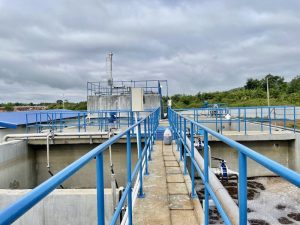
The completed pig farm wastewater treatment tank complex was built by Nam Viet
Biochemical equation of biological denitrification process:
Depending on the carbon-containing wastewater and nitrogen source used.
- Energy equation using methanol as electron acceptor:
6 NO3– + 5 CH3OH -> 5 CO2 + 3 N2 + 7 H2O + 6 OH-</sup >
- The entire reaction includes biomass synthesis:
NO3– + 1.08 CH3OH + 0.24 H2CO3< /sub> -> 0.056 C5H7O2N + 0.47 N2 + 1.68 H2O + HCO3–
O2 + 0.93 CH3OH + 0.056 NO3– -> 0.056 C5H7O2N + 0.47 N2 + 1.04 H2O + 0.59 H2CO3 + 0.56 HCO3–
- Energy equation using methanol, ammonia-N as electron acceptor:
NO3– + 2.5 CH3OH + 0.5 NH4+</ sup> + 0.5 H2CO3 -> 0.5 C5H7O2N + 0.5 N2</sub > +4.5 H2O + 0.5 HCO3–
- Energy equation using methane as electron acceptor:
5 CH4 + 8NO3– -> 4 N2 + 5 CO2 + 6 H2O + 8 OH–
- The entire reaction including biomass synthesis uses wastewater as carbon source, ammonia-N, as electron acceptor:
NO3– + 0.345 C10H19O3N + H< sup>+ + 0.267 NH4+ + 0.267 HCO3– -> 0.612 C5H7O2N + 0.5 N2 +2.3 H 2O + 0.655 CO2
The biochemical equation using methanol as the carbon source converting nitrate to nitrogen gas is significant in design: Reduced oxygen demand 2.86 g/g reduced nitrate.
The alkalinity produced is 3.57gCaCO3/g reduced nitrate if nitrate is the nitrogen source for cellular synthesis.
If ammonia-N is available, the alkalinity produced is lower than 2.9-3g CaCO3/g reduced nitrate.
Treatment by Aerobic Biological method:
The aerobic biological tank is the unit that determines the treatment efficiency of the system because most of the pollutants in wastewater are organic substances that are easily biodegradable.
In addition, suspended microorganisms are populations of aerobic, anoxic and anaerobic microorganisms stratified in order from the outside in, creating a multi-environment to treat a mixture of pollutant components such as BOD, COD, N, P thoroughly and specifically.
Wastewater after oxidizing organic compounds & converting Ammonium into Nitrate will be circulated to the anoxic biological tank for denitrification.
Nitrification process
Is the oxidation of nitrogen-containing compounds, first ammonia is converted to nitrite and then nitrite is oxidized to nitrate.
The nitrification process takes place in two steps involving two types of autotrophic microorganisms Nitrosomonas andNitrobacter
Step 1: Ammonium is converted to nitrite by the species Nitrosomonas:
NH4+ + 1.5 O2 -> NO2– + 2 H+ + H2O (1)
Step 2: Nitrite is converted to nitrate by the species Nitrobacter:
NO2– +0.5 O2 -> NO3– (2)
Reaction equations (1) and (2) produce energy. According to Painter (1970), the energy produced from ammonia oxidation is about 66¸84 kcal/mole ammonia and from nitrite oxidation about 17.5 kcal/mole nitrite. Nitrosomonas and Nitrobacter use this energy for cell growth and maintenance of life. The synthesis of the two reactions is rewritten as follows:
NH4+ + 2 O2 -> NO3– + 2 H+ + H2O (3)
From equation (3), the amount of O2 consumed is 4.57 g/g oxidized NH4+-N, in of which 3.43g/g is used to create nitrite and 1.14g/g is used to create nitrate, 2 equivalents of H+ ions are produced when oxidizing 1 mole of ammonium, H ions + back reacts with 2 equivalents of bicarbonate ions in wastewater. As a result, 7.14g of CaCO3 alkalinity is consumed/g NH4+-N is oxidized.
Equation (3) will change slightly when biomass synthesis is considered, the oxygen demand will be less than 4.57g since oxygen is also obtained from CO2 fixation, Some ammonia and bicarbonate enter the cell.
Along with the energy gain, ammonium ions are consumed into the cell. The biomass reaction is written as follows:
4 CO2 + HCO3– + NH4 + H2O – > C5H7O2N + 5 O2
- According to U.S.EPA Nitrogen Control Manual (1975): the entire oxidation and biomass synthesis reaction is written as follows:
NH4+ + 1.83 O2 +1.98 HCO3-</sup > -> 0.021C5H7O2N + 0.98 NO3– + 1.041 H2O +1.88 H2CO3
The O2 requirement is 4.2 g/g oxidized NH4+ -N.
- According to Gujer and Jenkins (1974): the entire oxidation and biomass synthesis reaction is written as follows:
1.02 NH4+ + 1.89 O2 +2.02 HCO3– -> 0.021C5H7O2N + NO3– + 1, 06 H2O +1.92 H2CO3
O2 demand decreased to 4.3 gO2/g NH4+ was oxidized, the alkaline consumption increases to 7.2 g/g NH4+ is oxidized.
Biological settling tank:
The main task is to settle microbial sludge flocs from the biological process and separate these sludge flocs from wastewater.
Wastewater from the aerobic biological tank is led into the central pipe to distribute evenly over the entire horizontal area at the bottom of the tank.
The central pipe is designed so that the water leaves the pipe and goes up at the slowest speed (in a static state), then the formed sludge flocs have a density large enough to overcome the upward speed of the wastewater flow. settle to the bottom of the settling tank.
Excess sludge deposited at the bottom of the settling tank is concentrated by the sludge wiper to the middle of the bottom of the tank and is led through the biological sludge collection tank.
At the biological sludge collection tank, the sludge will be circulated to the anoxic and aerobic biological tanks. The remaining sludge will be dried and bagged.
Disinfection tank:
Wastewater after biological treatment, especially pig farming wastewater, still contains about 105 – 106 bacteria in 100ml, most types of bacteria. This bacteria that exists in wastewater is not a disease-causing bacteria, but it does not exclude some species of bacteria that can cause disease.
When chlorine is added to water, the strong oxidizing chemical chlorine will diffuse through the microbial cell envelope and react with enzymes inside the microbial cells, disrupting the metabolic process, leading to bacteria. creatures are destroyed.
Finished lake:
The finishing pond is built to improve the quality of wastewater output from the final treatment unit, the quality of treated water meets standards and legal requirements.
Organic compound residues and suspended solids content are minimized, but the main task of the finishing pond is to improve hygiene quality by measuring the concentration of indicator microorganisms: worm eggs and coliform Removal of Conforms is normally the slowest treatment process, so it is the main criterion for the final pond design.
Incident lake:
In order to provide backup for wastewater treatment works to ensure water retention time according to current law regulations.
Sludge treatment
Sludge tank: Sludge is pressed by a sludge press and collected and processed according to regulations
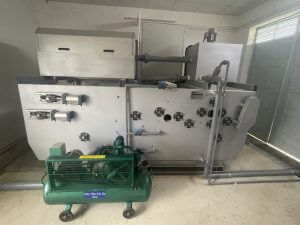
Belt conveyor sludge dewatering machine installed by Nam Viet
Discharge and reuse after treatment of pig farming wastewater.
Treated wastewater meets environmental discharge standards according to regulations and can be reused for washing barns, watering plants, cleaning…
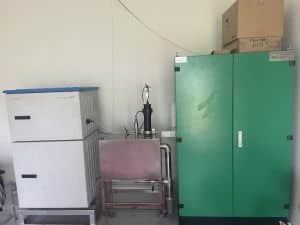
Automatic monitoring cabinet to check output water quality
Nam Viet ETC is a unit that has a lot of experience in constructing livestock wastewater treatment systems, especially pig farms, that meet standards and standards. bring economic efficiency to customers. If you need advice or design a quote, please contact us for more detailed support.
- Consultation is completely free. Customers just need to call or text our staff in charge and will come to your location to advise on surveys, or advise customers over the phone.
- Design and construction of manure collection and separation systems. Ensures separation of most feces in wastewater.
- Construction of the Biogas system minimizes pollution concentration and can use gas as fuel.
- Construction and installation of wastewater treatment systems with a team of qualified, young and enthusiastic engineers.
- Instructions for operating and handing over technology, ensuring that Customer’s employees understand, understand and handle situations and problems that may occur.
- Warranty, maintenance, thoughtful customer care 24/7.
Hotline 0932562177

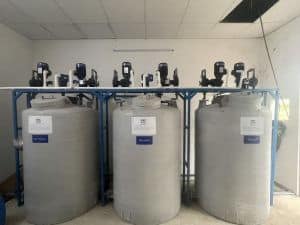


Bài viết liên quan
UASB tank in wastewater treatment
Introducing the UASB tank UASB stands for Upflow Anaerobic Sludge Blanket, roughly translated as reverse...
Wastewater treatment of carton paper packaging production
Origin of wastewater from carton packaging production Wastewater containing printing ink generated during the production...
Common Aerotank tank problems and how to fix them
Aerotank incidents during the operation of the WWTP often arise equipment problems such as pumps,...